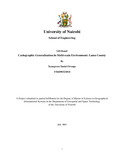Cartographic generalization in multi scale environment Lamu County

View/
Date
2013-07Author
Nyangweso, Daniel O
Type
ThesisLanguage
enMetadata
Show full item recordAbstract
Generalization generally depends on the map purpose, extent of area of interest and a desired
scale. Survey of Kenya, Kenya’s National Mapping Agency, produces large amounts of different
data sets of geospatial data and at different scales. Hence there is duplication of effort, large data
storage requirement, process is slow and the data is not combined and harmonized correctly.
There is also loss of detail in the down scaling.
This paper discusses the process of vector based cartographic generalization of Lamu Vector
base data at scale of 1:5,000 using GIS software generalization tools of arcGIS 10.1 and
Quantum GIS 1.8 v. Generalization toolset. The end products were generalized maps at scales of
1:10,000, 1:50,000 and 1:100,000 produced in a fast, efficient manner to produce detailed
updated maps. The base data was contained in a file geo-database at scale of 1:5,000 was then
generalized to geo-databases at scales of 1:10,000, 1:50,000 and 1:100,000. The base data
contained feature datasets categories such as topographical, transportation, water areas,
vegetation boundaries, swamps and other special and unclassified data. General specifications
and constraints for each scale of generalization were used to symbolize the layers after
generalization. Contour and spot height data were regenerated by changing contour interval and
spot height spacing, for each scale, using Global mapper.
From the results obtained it indicates that, GIS cartographic generalization provides a good
opportunity to generalize large scale data. The process is fast and efficient and would enable one
to obtain updated detailed maps up to two times. However there is a requirement of editing and
symbolization to preserve important details. Hence there is a need to formalize on how to use
GIS software generalization techniques, to combine and harmonize data through generalization
to scales desired.
Citation
Bachelor of Architecture, University of Nairobi, 2013Publisher
University of Nairobi
